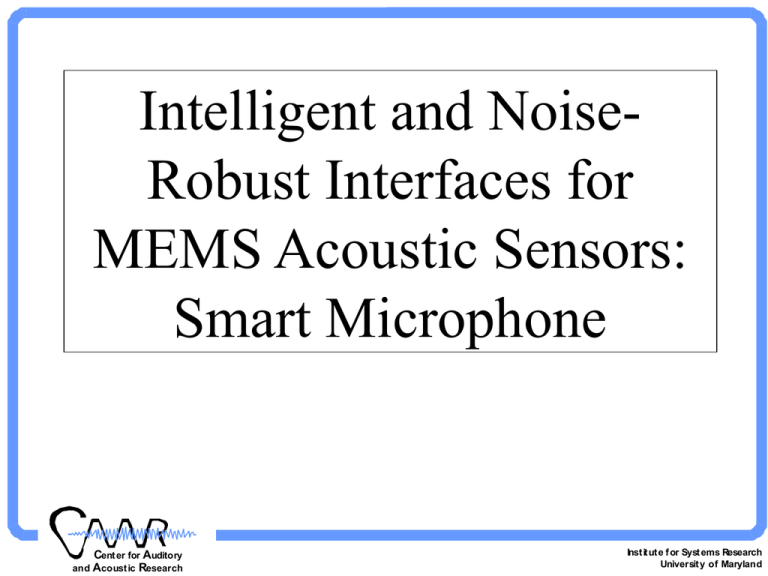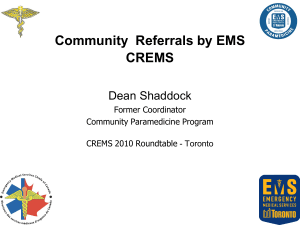sas_talk - Institute for Systems Research
advertisement

Intelligent and NoiseRobust Interfaces for MEMS Acoustic Sensors: Smart Microphone Cent er for Auditory and Acoust ic Research Inst it ut e f or Syst ems Research Universit y of Maryland UNIVERSITY OF MARYLAND Electrical and Computer Engineering & Psychology Departments Baras, Horiuchi, Krishnaprasad, Moss, Shamma THE JOHNS HOPKINS UNIVERSITY Electrical and Computer Engineering Department Andreou, Cauwenberghs, Etienne-Cummings UNIVERSITY OF SIDNEY Electrical Engineering Department van Schaik SIGNAL SYSTEMS CORPORATION Riddle, Murray COLLABORATIONS Institute for Neuroinformatics, ETH Army Research Laboratory Cent er for Auditory and Acoust ic Research Inst it ut e f or Syst ems Research Universit y of Maryland PROJECT GOALS AND MISSION Overall Mission Formulate, design, and implement signal processing systems and technology that can adapt, control, and utilize the noisy MEMS sensor signals Specific Approach Focus Area I Characterize and integrate M EMS sensors with aVLSI circuits that detect and receive the signals. Cent er for Auditory and Acoust ic Research Focus Area II Noise control in M EMS sensor arrays through design and fabrication of versatile analog VLSI M EMS interface and associated feature extraction and analysis stages Focus Area III Embedding and demonstrating the functional capability of the integrated M EMS/VLSI sensor and signal processing arrays in a moving robotic vehicle. Inst it ut e f or Syst ems Research Universit y of Maryland Specific Objectives Objective 1 Formulate strategies for interfacing with acoustic MEMS Objective 2 Develop and implement wind-noise and platform-noise reduction algorithms in VLSI Objective 3 Implement VLSI co chlear frequency analysis 2000 log f 1000 log u 500 log f log f u log f 250 125 100 log f Objective 4 Design and fabricate feature extraction algorithms 200 300 400 500 Time (ms) 600 700 800 900 1000 NSL TOOLBOX Cortical Decomposition of Sound QuickTime™ and a Photo - JPEG decompressor are needed to see this picture. Objective 5 Feature synthes is and recognition Objective 6 Technology transf er and demonstrations Cent er for Auditory and Acoust ic Research Inst it ut e f or Syst ems Research Universit y of Maryland Acoustic and Ultrasonic Transducers (AGA, REC) Prototype and Evaluate Various Types of MEMS Microphones/Speakers Custom Microphones/Speakers Cent er for Auditory and Acoust ic Research Commercial Transducers Inst it ut e f or Syst ems Research Universit y of Maryland Integrated MEMS Acoustic and Ultrasonic Arrays (AGA, REC) Prototype and Evaluate Various Types of MEMS Microphone/Speaker Arrays 2D Piezo Arrays Ceramics and Polymers Cent er for Auditory and Acoust ic Research 2D MEMS Arrays Capacitive Micro-Membranes Inst it ut e f or Syst ems Research Universit y of Maryland Vision: • A small, low power microphone interface for acoustic sensors that reduces turbulence and vibration induced noise on military platforms such as battlefield robotics Primary Microphone Port Polyurethane foam windscreen 1/2” Secondary Sensor Port for Wind Sensing Mounting plate Connector Microphones Preamps aVLSI noise reduction circuitry 1” Cent er for Auditory and Acoust ic Research Inst it ut e f or Syst ems Research Universit y of Maryland MEMS/VLSI Integration and Prototyping (REC,AGA) Develop Integrated Processing Electronics for Transducers Integrated Transducers and Electronics Cent er for Auditory and Acoust ic Research Transduction Electronics Inst it ut e f or Syst ems Research Universit y of Maryland • Approach: – Utilize multi-channel adaptive filtering modules based on aVLSI biomimetic technology • Analog filter banks with Independent Component Analysis (ICA) and Least Mean Squares (LMS) adaptation – Incorporate low noise preamps; acoustic and vibration sensors – Develop specification and prototypes – Demonstrate in acoustic duct and installed on unmanned land vehicle Acoustic Sensors Wind Noise Sensor Multi-Resolution Low noise acoustic signals Adaptive Filter Noise and Vibration Sensors Cent er for Auditory and Acoust ic Research Inst it ut e f or Syst ems Research Universit y of Maryland Cochlear Frequency Analysis • We will design a new silicon cochlea with the following features: – – – Increased robustness due to 2D design Integrated Inner Hair Cell Model Reproducible settings of the parameters Magnitude Response Phase Response Cent er for Auditory and Acoust ic Research Inst it ut e f or Syst ems Research Universit y of Maryland Stochastic Resonance Exploit stochastic resonance (noise-induced enhancement of spectral power amplification SPA) in conjunction with auditory-inspired (e.g. cochlear) sensor signal processing architectures External World Band-pass filter + Threshold detector Controlled noise generator circuit MEMS heater Cent er for Auditory and Acoust ic Research K Inst it ut e f or Syst ems Research Universit y of Maryland Adaptive Filtering and Blind Source Separation (GC, AGA) Static and Dynamic ICA (Independent Component Analysis) Adaptive Noise and Wind Cancellation without Need for Isolated Reference Dynamic ICA Array Processor Cent er for Auditory and Acoust ic Research Adaptive Cell Inst it ut e f or Syst ems Research Universit y of Maryland Filtering Auditory-Based Sound Separation X1 X2 X1 X2 A S1 S2 De-noising 1 H1 v v 1 1 H2 v v 1 2 w w ICA1 2 2 w w 2 ICA2 2 1 1 1 2 1 2 Grouping 2 And X1 X2 . . Competitive . . Learning . . . X1 X2 v v HN . N 1 N w w ICAN 2 w w 1 2 w sö y wx N 1 N 2 Early Auditory Models lo g f u lo g f S1 l gf u lo g f ICA lo g f u lo g f S2 Cent er for Auditory and Acoust ic Research l gf u lo g f Cochlea Hair cell Lateral Inhibition Inst it ut e f or Syst ems Research Universit y of Maryland Cochlear Feature Extraction (AGA, GC) Neuromorphic implementation with asynchronous “spiking” outputs BM in BM out auditory nerve hair cells 15 channels cochlea AM Energy TZC (single channel) TZC FM BM out Time Cent er for Auditory and Acoust ic Research Inst it ut e f or Syst ems Research Universit y of Maryland Early Auditory Processing Stages Analysis Transduction Reduction Cochlea r f ilt er s Hair ce lls Lat er al i nhib i t io n 2000 log f 1000 log u 500 log f log f u log f 250 125 100 log f eardrum / r i cochlea t basilar membrane filt ers a w a hair cell st a ges lat era l inhibit ory net work 200 300 400 500 Time (ms) 600 700 800 900 1000 Audit or y Spec t rogr am y / 4000 4000 250 250 Time ( ms ) Cent er for Auditory and Acoust ic Research 500 Time ( ms ) 500 Inst it ut e f or Syst ems Research Universit y of Maryland Multiresolution Preprocessor: Auditory Filtering Multiresolution cortical filter outputs Fast Rate Fine Scale Slow Rate Fine Scale Upward Moving Fast Rate Coarse Scale Slow Rate Coarse Scale Slow Rate Fine Scale Fast Rate Fine Scale Downward Moving Slow Rate Coarse Scale Fast Rate Coarse Scale • The second filter models the multiscale processing of the signal that happens in the auditory cortex • A Ripple Analysis Model, using a ripple filter bank, acts on the output of the inner ear to give multiscale spectra of the sound timbre (Wavelet Transform) Cent er for Auditory and Acoust ic Research Inst it ut e f or Syst ems Research Universit y of Maryland Auditory Processing of Vehicle Signals: Cortex 70 60 scale 50 40 30 20 10 0 20 40 60 80 100 120 Auditory frequency Example of multi-resolution representation from cortical module Cent er for Auditory and Acoust ic Research Inst it ut e f or Syst ems Research Universit y of Maryland Wavelet TSVQ Applied to Acoustic Vehicle Classification • Objective: a prototype vehicle acoustic signal classification system with low classification error and short search time • Biologically motivated feature extraction models: cochlear filter banks and A1-cortical wavelet transform • Vector Quantization (VQ) based classification algorithm. Including learning VQ (LVQ) and tree structured VQ (TSVQ) Acoustic Recording Preprocessing Peripheral auditory processing model Cortical processing model Feature extraction system VQ based Classification Algorithm Classification Result Algorithm Flowchart Cent er for Auditory and Acoust ic Research Inst it ut e f or Syst ems Research Universit y of Maryland Acoustic Transient Time-Frequency Analysis (GC, w/ APL) Models “Ripple” Dynamics of Cells Recorded in Auditory Cortex (Shamma) audio in Segmenter “Shelf” (class 10) “Tub” (class 11) Continuous Wavelet Filterbank 32 (freq) 32 (freq) X 64 (time) ATP Time-Frequency Template Correlator 16 (templ.) ... 16 (12 used) Digital Postprocessor Cent er for Auditory and Acoust ic Research Inst it ut e f or Syst ems Research Universit y of Maryland BINAURAL LOCALIZATION NM/NL (ITD processing) Cochlear filters ICc NA ICx VLVp (ILD processing) ABL Cochlear filters NM/NL (ITD processing) ICc NA ICx VLVp (ILD processing) Cent er for Auditory and Acoust ic Research Inst it ut e f or Syst ems Research Universit y of Maryland Stereausis: A Biologically Plausible Binaural Network. A binaural sound localization system will be developed using 2 silicon cochleas and an aVLSI implementation for ILD and ITD detection. Cent er for Auditory and Acoust ic Research Inst it ut e f or Syst ems Research Universit y of Maryland Cent er for Auditory and Acoust ic Research Inst it ut e f or Syst ems Research Universit y of Maryland Coc hlear filt ers A hair cell st ages lat eral Temporal inhibit ion Sharpening Coincidence C ij = z(t ; i).z(t; x=1 log f Mat rix j) Z(t; i) log f x=128 log f B r(t; x) .125 y(t; x) Z(t; j) z(t ; x) .125 .125 .2 5 .5 .25 1 1 1 2 2 2 .25 .5 200 .5 200 C Cent er for Auditory and Acoust ic Research Inst it ut e f or Syst ems Research Universit y of Maryland BATS Cent er for Auditory and Acoust ic Research Inst it ut e f or Syst ems Research Universit y of Maryland Steerable Range Gauging and Echolocation (REC) Develop Ranging Signal Processing Algorithms Cent er for Auditory and Acoust ic Research Inst it ut e f or Syst ems Research Universit y of Maryland Massively Parallel Kernel Learning “Machines” (GC) Kernel “machines” subsume LVQ, RBF and SVM classifiers Locally adaptive, distributed memory Scalable and modular Factor 100-10,000 more efficient than CPU or DSP Parallel vector quantizer Cent er for Auditory and Acoust ic Research Inst it ut e f or Syst ems Research Universit y of Maryland Integrate-and-Fire Address-Event VLSI Neural Networks (GC & AGA) T itle: c hip2.eps Creator: Xcircuit v2.0 Preview: T his EPS pic ture was not s aved with a preview i nc luded i n i t. Comment: T his EPS pic ture wi ll pri nt to a Pos tScri pt printer, but not to other types of printers. Scalable, multi-chip architecture for “neural” computations Address-event routing circuit provides for arbitrary interconnection topologies Analog-valued synaptic weights are implemented by probabilistically transmitting address-events Integrate-and-Fire Array Address-Event Transceiver Chip Cent er for Auditory and Acoust ic Research Inst it ut e f or Syst ems Research Universit y of Maryland Address-Event Asynchronous Communication and Computation (AGA, REC, GC) The multi-chip modular, scalable approach to system integration Cent er for Auditory and Acoust ic Research Inst it ut e f or Syst ems Research Universit y of Maryland New design: An AER cochlea chip • Currently in fabrication • 128 output channels • Both for sonar and audio • New silicon process (0.35um minimum feature size versus 2.0um) •AER makes inter-chip communication possible. •AER allows manipulation of output such that projective fields are readily implemented. Cent er for Auditory and Acoust ic Research Inst it ut e f or Syst ems Research Universit y of Maryland Cent er for Auditory and Acoust ic Research Inst it ut e f or Syst ems Research Universit y of Maryland 1-D Address-Event Transceiver with Diode-Capacitors Integrators (AGA) Address Event (AE) transceiver circuit is a modular element for future multidimensional communication between neuromorphic chips. Input AE data is processed by the sigmoid function of the nonlinear diode-capacitor integrators . The data is retransmitted using the AE protocol with an arbitrated queueing communication system. 1-D Address-Event Transceiver Chip Cent er for Auditory and Acoust ic Research Inst it ut e f or Syst ems Research Universit y of Maryland • Impact: – Enable effective acoustic surveillance for Future Combat Systems – Increase by 20 dB the turbulence induced noise rejection of acoustic sensors relative to passive treatments of the same size, using active noise control – Increase by 20 dB the platform noise rejection of acoustic sensors over existing methods Demo III Experimental Unmanned Vehicle Cent er for Auditory and Acoust ic Research Inst it ut e f or Syst ems Research Universit y of Maryland The Robots Microphones Speakers Wireless camera Sonar sensors Touch sensors Cent er for Auditory and Acoust ic Research Inst it ut e f or Syst ems Research Universit y of Maryland








